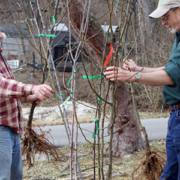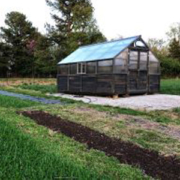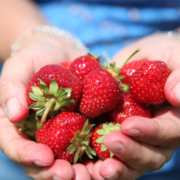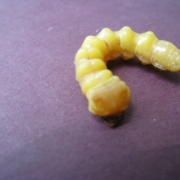Fall Planting Fruit Trees
 Print This Post
Print This Post
A Hair’s Breadth Makes a Huge Difference
By Guy K. Ames, NCAT Horticulture Specialist
All across the South and as far north as USDA Climate Zone 5, fall planting of fruit trees can help get fruit trees off to a big head-start compared to fruit trees planted in spring. Why? The answer is a small thing and as thin as the thinning hairs on my old head.
First, let’s establish that for our horticultural purposes “fall” is when the leaves have fallen and nursery trees have gone dormant (or mostly so). Fall will occur, then, at different times at different places depending on the weather of a particular year. Most years in Northwest Arkansas, where I live, fall occurs in early-mid November. I’ve been growing nursery trees for 39 years, so I’ve paid attention to the timing of this phenomenon. When I started out fall was more-or-less dependably around Halloween. Now it’s much more likely to be closer to mid-November, a two week difference. Fall is NOT contemporaneous with football season! It’s important that “fall” is etymologically and horticulturally equal to “leaf fall.”
Getting to the Root (Hair) of the Matter
Before leaf fall, leaves transpire moisture. That is, as part of their function in the plant, they release water into the atmosphere, water that was initially taken up by the roots. And not just any kind of root can take up water. What most of us recognize as roots are the big, twig and limb-sized roots that actually function only as storage and anchorage. These big roots do not do the actual work of taking up water and nutrients. Tiny root hairs do that job!
These root hairs are not microscopic, exactly, but they are tiny and easily overlooked by the casual observer. Root hairs are also very tender and short-lived. Somewhat analogous to our own skin cells, root hairs are constantly dying off and being replaced. The average root hair probably lives about two to four weeks. The root hairs are so small and tender that when a gardener or orchardist transplants a tree, it is practically inevitable that most root hairs will break off from their tenuous connections to a larger root. This is true of both potted and bare-root trees. The most careful gardener will not be able to completely avoid this damage. Even large balled-and-burlapped trees will suffer considerable root hair loss simply by the movement and vibration of the transplanting process.
So, if a fruit tree is transplanted when it still has or is developing green leaves, the leaves will be transpiring moisture that is not being replaced in the tree by water uptake by the root hairs. The resulting stress to the tree is called “transplant shock.” The most visible symptom is usually drooping or dying leaves. Such shocked trees usually go on to survive, but might struggle at first, especially if there are other stress factors.
Fall Planting Advantages
In comparison, a fall-transplanted tree (all other factors being equal), will rapidly outgrow such a stressed tree because it has replaced all those root hairs over the winter. In fact, in most of the South (let’s say zones 6 and warmer), while the above-ground tree looks dormant and asleep, the roots—all the roots, including the root hairs—can continue to grow whenever soil temperatures are above freezing. It will be better anchored, the root hairs will already be functioning, and it will SPRING to life when the air temperatures prompt it to wake up.
Now that you know this, you can infer that in most of the South with relatively warm soil temperatures throughout the winter, a tree planted in November will outperform a tree planted in March or April. But so will a tree planted in December, January or February! Fall planting is probably best. But give the little root hairs any reasonable time to be regenerated—let’s say four weeks before expected leaf out. Your transplanted tree will almost certainly outperform a bargain tree, already leafed out, bought off of a grocery store parking lot in March or April while you were in the thick of spring fever!
This blog is produced by the National Center for Appropriate Technology through the ATTRA Sustainable Agriculture program, under a cooperative agreement with USDA Rural Development. ATTRA.NCAT.ORG.





 wikicommons Zeynel Cebeci
wikicommons Zeynel Cebeci





